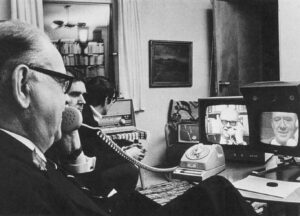Communicating in times of COVID-19
How Zoom videoconferencing has ventured its way into our life… and is here to stay? Lessons from history.
Coming together as international, interdisciplinary students from four countries, we are going to get on a cultural journey looking at and assessing the effects of a technology or media. During the preparation of this summer school, all members of our group chose one technology that they were interested in and analyzed it from different perspectives of interest. Drawing on these technologies, we came together as a group with a basic understanding of socio-technological entanglements, heightened through the current pandemic. But how were we able to talk to each other face-to-face when the borders of the countries we reside in are still closed? Well, our lecturers chose Zoom videoconferencing as the way to go.
Interestingly, our group entailed different but still very similar technologies. Among these were earphones (especially noise-canceling earphones), the TV, Microsoft Teams and… Zoom. Without even realizing it, we started to talk about Zoom and how we feel about using it day in and out for our lectures, our private life, or our work. While Zoom enables us to hold this Summer School even though we are in the middle of a global pandemic, there were also several factors that our team members felt discomforted with. For example, Zoom strains our battery – not only the battery of our phones but also our own “battery”. Moreover, we lose the ability to focus on a lecture, missing “real” interaction.
Being a part of a network, only possible to use with internet access and a personal device to log in with, Zoom is only one application of a bigger network of communication technologies. Inspired by a lecture from Prof. Dr. Claus Pias, we started to think about the historical development of such communication tools. Did you know that the radio, the TV, and the telephone were all developed within 20 years during the late 18th century? Well we certainly were not aware of this. The basic idea for videoconferencing was only developed slightly later during the 1930s when the telephone became widely popular and accessible. But what drove those developments? Why did Mr. Bell see the need to develop the telephone? And why did somebody want to develop an alternative for telephony by inventing videoconferencing? Well we think that such technological developments were always driven by societal development – for example the great immigration waves from Europe to the US. Back then, people were searching for vicinity and proximity to their loved ones, looking for a feeling of home and comfort, for example the voice of your relatives or pictures of their home country. Throughout history, these technologies have changed their purpose continuously. The underlying technology was constantly developed, only the terminology used to describe it remained unchanged – think about the several artefacts all referred to as a phone.

Swedish Prime Minister Tage Erlander using an Ericsson videophone to speak with Lennart Hyland, a popular TV show host (1969). Image via method shop
Zoom as one of the most popular solutions for videoconferencing was originally developed as a conferencing tool for companies. As an add-on to normal telephone conferences, companies were enabled to hold face-to-face meetings with members from all over the world. Face-to-face communication produced a feeling of personal proximity and community.
Nowadays though Zoom is used for several private and work-related meetings. Different than our ancestors adopting the telephone, we were forced to adapt Zoom within days. Driven by the global rise of the COVID-19 pandemic, most companies and universities quickly transferred to the video-conferencing platform. Leaving users with no time to adjust, an interesting effect could be observed: People started to compare Zoom to other communication tools and were dissatisfied with the “new normal”. Suddenly people craved for “social noise” such as a loud street or cafeteria. This effect is also known as the historical narrative of loss.
So, let us take a step back. Before trying to analyze and judge the technology of Zoom, we want to try to understand it better from a technological, historical, and societal perspective. Oftentimes, politicians and innovators believe that the investment in technology will solve all related issues (as we can also see with the current search for a vaccine for the Sars-Cov-2 virus). However, this ignores the drivers of the development of new technology. Because in the end a technology (at the moment) does not develop itself, it does not “know” how to improve or change if not for a smart coder or technician. Thus, this week, we want to take a holistic perspective on the technology of Zoom, how we as individuals perceive it, feel about it, and think about it.
“See you” tomorrow!
Alma, Bea, Davide, Karolina & Oskar